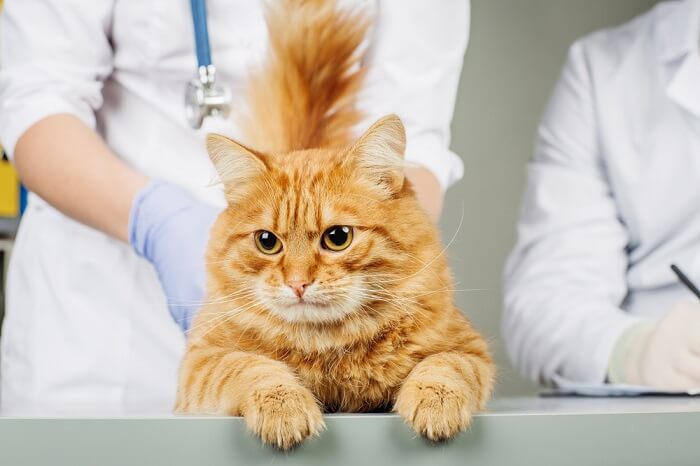
Fluoxetine, also commonly known by the brand name Prozac, is a medication commonly used in veterinary medicine to treat behavioral disorders, including inappropriate urination, in cats.
In this article, you’ll learn how fluoxetine works, situations where it is often prescribed, potential side effects and drug interactions, and some frequently asked questions.
Fluoxetine for Cats Overview

About Fluoxetine for Cats
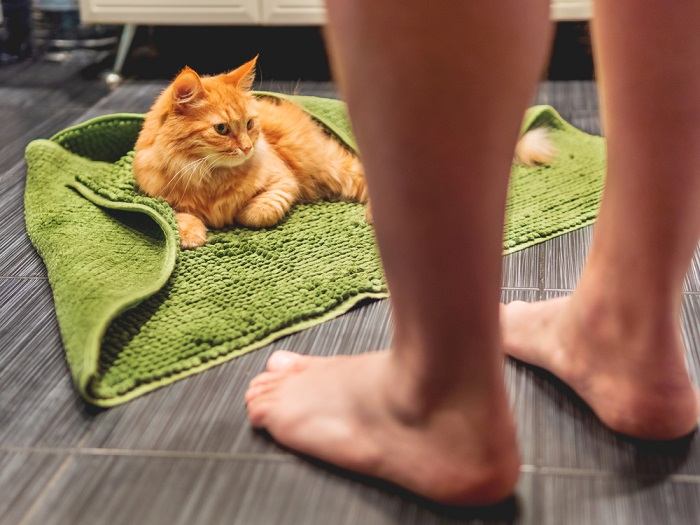
Fluoxetine is classified as a selective serotonin reuptake inhibitor (SSRI) antidepressant.
Serotonin is a principal hormone in the body that acts as a neurotransmitter in the brain. It is the main transmitter involved with stabilizing mood, well-being, and happiness.
Also Read: 6 Subtle Signs Your Cat Loves You
SSRIs act to increase serotonin levels in the brain by preventing its reuptake or reabsorption, keeping it in circulation.
Fluoxetine is very selective in that it has little effect on other neurotransmitters in the brain, primarily just serotonin.
What Does Fluoxetine Do for Cats?
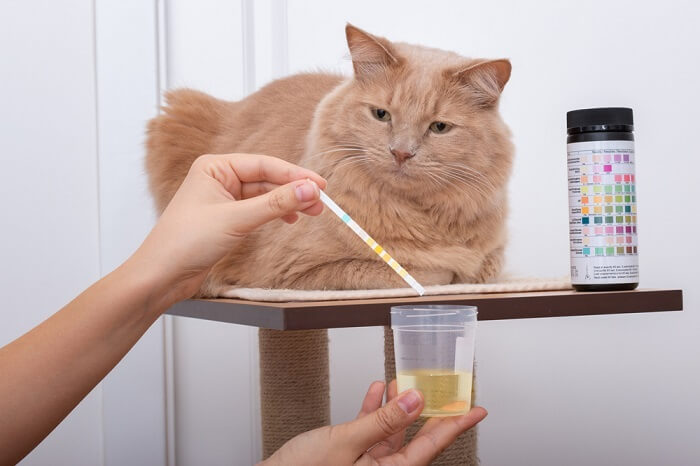
Generally, fluoxetine may be used for a variety of behavioral disorders, including aggression, obsessive-compulsive behaviors, separation anxiety, and inappropriate elimination.
Cats are very complex creatures, as all kitty parents know, and they can exhibit some very odd behaviors interacting with their human counterparts as well as other pets in the home.
It is important to rule out medical causes of unusual behaviors, like underlying pain as a cause of erratic behavior or aggression, or infection, bladder stones, or sterile inflammation as a cause of unwanted urinary behavior.
But generally, if medical causes have been eliminated, and some non-prescription behavioral approaches (such as pheromone diffusers or sprays) may have been tried, fluoxetine is often a first choice for many behavioral conditions in cats. This is especially true for cases of inappropriate urination.
Side Effects of Fluoxetine for Cats
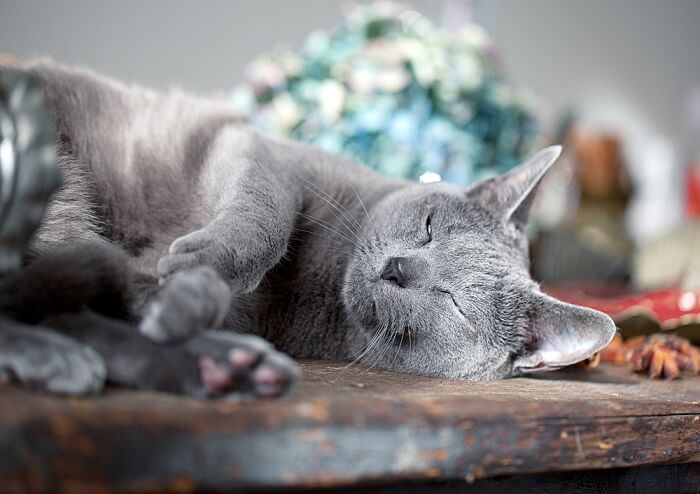
While many cats may experience improved, calm behavior as desired, rarely cats may exhibit worsening behavior changes like anxiety, hyperactivity, irritability and difficulty sleeping.
In cats, fluoxetine can have a number of potential adverse effects.
The most commonly reported effects can be drowsiness and a decrease in appetite.
While many cats may experience improved, calm behavior as desired, rarely cats may exhibit worsening behavior changes like anxiety, hyperactivity, irritability, difficulty sleeping, and undesired changes in elimination patterns.
Cats can also develop GI side effects like poor appetite, nausea, vomiting, or diarrhea. All potential side effects are not universal, but vary greatly from cat to cat in terms of what may occur and to what degree.
Fluoxetine can have interactions with many medications, especially other anxiety medications, sedatives, and some pain medications. Some drug interactions, especially when fluoxetine is used with a monoamine oxidase inhibitor (MAOI) like selegiline, may lead to serotonin syndrome, which is described more fully below. Always make your veterinarian aware of any other medications your cat is taking.
If your cat uses a flea/tick collar, make sure to discuss this with your vet prior to starting fluoxetine.
Fluoxetine should be used with caution in diabetic patients, as its use with insulin may alter insulin requirements. It may be a common recommendation after starting fluoxetine in a diabetic cat, to have blood glucose levels rechecked to see if any adjustments need to be made.
Fluoxetine is primarily metabolized by the liver, and so should be used cautiously in any cat with chronic or advanced liver disease.
Overdoses of fluoxetine can be very concerning. While increasing serotonin in the body can be helpful with some behavioral disorders, increasing it too much can lead to severe side effects including vomiting, excessive drooling, diarrhea, agitation, tremors, and seizures. This is called serotonin syndrome and requires immediate veterinary care if it occurs.
If you are ever concerned that your kitty may have developed side effects while taking fluoxetine, or if you think an overdose or medication interaction may have occurred, make sure to contact your veterinarian, the ASPCA Animal Poison Control Center (1-888-426-4435), or Pet Poison Helpline (1-855-764-7661) for further advice.
Fluoxetine for Cats Dosage
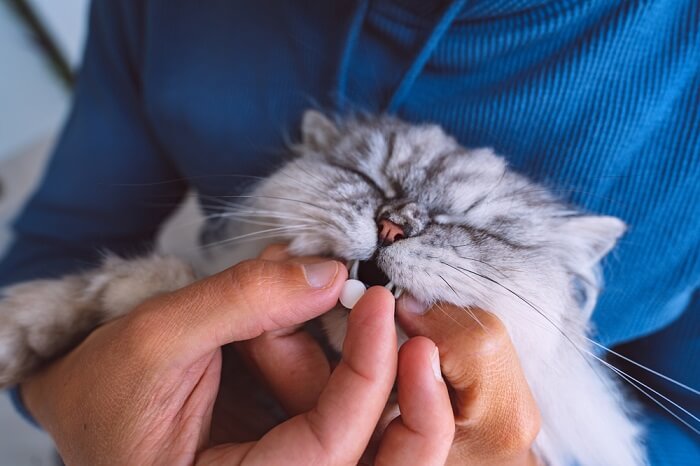
Fluoxetine is generally dosed once daily and when first started should be continued for at least 4 to 8 weeks as long as no concerning side effects are seen.
While fluoxetine is labeled for use in dogs as the brand Reconcile, there is no FDA approved product for cats, so it is used in an extra-label manner in kitties.
Starting doses for cats tend to be low and this medication has a narrow margin of safety, so a dosage for your cat is best determined by your cat’s attending veterinarian.
Doses may be given with or without food.
Doses as low as 15-20mg for an average 10 lb cat have demonstrated signs of toxicity, so under no circumstances should a human dose of Prozac be shared with a cat in the home.
Fluoxetine is generally dosed once daily and when first started should be continued for at least 4 to 8 weeks as long as no concerning side effects are seen, to fully determine if the drug is working to address a behavioral problem.
It is extremely important to not discontinue this medication abruptly. If your cat is exhibiting signs of undesired behavior or side effects, make sure to contact your veterinarian first. If your cat has been on fluoxetine for several weeks and no improvements have been seen, it is very important to contact your vet to discuss, as weaning a kitty slowly off the medication is typical when looking to discontinue it.
It’s helpful to note that because cats require smaller doses of fluoxetine, that having the medication ordered through a compounding pharmacy, sometimes in a small treat or liquid form, is common. It’s important to be aware that the transdermal (skin application) form has been found in studies to be much less effective however for proper dosing.
Conclusion

Fluoxetine can be a very helpful and effective medication for treating cats for a variety of behavioral disorders, including inappropriate urination. But because side effects and drug interactions can occur, and because overdoses can be concerning, it’s very important for fluoxetine to only be used for cats when appropriately prescribed by an attending veterinarian.
Drug Dosing Disclaimer: We are only able to provide doses for medications that are FDA approved for use in cats and only as the label guidelines dictate. For medications that are used off-label we can only provide guidelines and safety information for use. Safe and appropriate dosing for off-label medications can only be determined by a primary care veterinarian.
We encourage you to work with your veterinarian to determine if a particular medication is appropriate for your cat. Changing or adjusting a dose for your cat on your own without consulting with a veterinarian can carry risk. We do not encourage use of medications prescribed for human use in pets without first consulting with a primary care veterinarian.
Frequently Asked Questions
What Does Fluoxetine Do for Cats?
Fluoxetine is a selective serotonin reuptake inhibitor (SSRI). It works by keeping serotonin levels higher in the body, which can help to improve mood and a sense of well-being.
How Long Does It Take for Fluoxetine to Work in Cats?
Drugs like fluoxetine can take a long time to reach their peak level of effectiveness. When starting fluoxetine it is possible to see behavioral improvements in as little as 1-2 weeks, but it is common to continue a cat on it for at least 4-8 weeks to fully assess its effect on a behavioral problem.
Whenever starting a drug like fluoxetine, it is important to be patient and not expect immediate results, but to carefully monitor your cat for slow, steady improvements. If you haven’t seen any improvements in an undesired behavior after 4 weeks, it is appropriate to update your veterinarian.
Make sure to never abruptly discontinue fluoxetine or any other behavioral medication, even if you think it may not be helping. It’s important to contact your vet first to determine the best way to discontinue it or transition to a different medication if desired.
Is Fluoxetine Safe for Cats?
Fluoxetine is safe for use in a majority of cats when prescribed by a veterinarian and dosed appropriately. As with any medication, side effects are always possible. Mild ones seen more commonly may include drowsiness and a decrease in appetite. When discussed with your vet, a simple medication adjustment may help. More concerning side effects or undesired behavioral effects tend to be much less common.
Overdoses or interactions with other medications may lead to serotonin syndrome, which can cause serious signs of illness. This most often occurs with accidental overdoses or if a human dosage equivalent of fluoxetine is given.
If you are ever concerned that your kitty may have developed side effects from use of fluoxetine, or if you think an overdose or medication interaction may have occurred, make sure to contact your veterinarian, the ASPCA Animal Poison Control Center (1-888-426-4435), or Pet Poison Helpline (1-855-764-7661) for further advice.
How Long Can a Cat Stay on Prozac?
A cat can stay on fluoxetine for life if needed. However, any behavioral medication should be given in light of both its continued necessity as well as other behavioral modification approaches.
If a stressor in the home, such as another pet or housing situation, which was the source of a cat’s undesired behaviors, has been resolved, a cat may no longer require this medication, or the dosage may be adjusted.
While training and behavioral modification is trickier for cats as compared to many dogs, products like Feliway and other approaches like litter box number and strategic placement for inappropriately urinating cats, may reduce the need for medication.
This is why it is always very important to update your veterinarian with any changes in your cat's status or the perceived source of stress, if known.
In many cases, a cat’s stressor may not be clear, but if it’s evident that a kitty is calmer and not exhibiting undesired behaviors while on fluoxetine, it is best to continue the medication as long as needed while the condition is being acceptably managed and no concerning side effects are being seen.




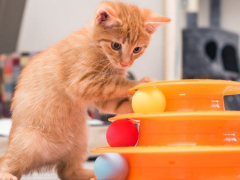


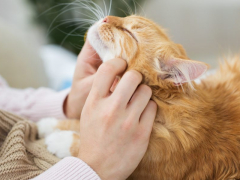
I adopted a cat who was brought in to be put down because it is very aggressive. The 8 mo old cat had been in two foster homes. I already have three older cats. It worked well for about a week,the cat is very attached to me, sleeps beside me, grooms my hair, follows me around the house. Over the weekend he because ver aggressive, wrapping himself around my legs, biting and scratching, doing the same things to my arms, drawing blood everytime. I have been using the Feliway diffusers in several locations and have a purple collar on hm. I thought he might enjoy a playmate so adopted another cat just a bit older. They enjoy playing, running through the house, etc. However his aggression was worse today. I had to scruff him to get him to let go.
He’s been through a lot and I surely don’t want to return him to my vet. He was fine for the first week, but his behavior changed without any change to the household. It improved a bit with the other new cat, but today he was very aggressive with me. What should I do?
Hi Marjorie, it sounds like the cat might be experiencing some stress. New environments can be scary, and it sounds like he’s already been through some major changes. When you brought him home, did you introduce him to the environment (and your other cats) slowly? Do all of your cats have individual space? Cats can sometimes become territorial in multi-pet homes, so it may help to provide this new cat with a little area he can call his own–even if it’s just a corner with his own bed, cat tree, and food bowls.
If you weren’t able to make the introductions slowly, it might help to separate the new cat for a little while. Keep him in a room with everything he needs (and a room where you can keep his bed and bowls after you let him loose) to give him time to settle in. It may help everyone get used to each other. Here’s a helpful article with some more tips: https://cats.com/how-to-introduce-a-new-kitten-to-an-older-cat
My 6 year old male cat started Fluoxetine on 10/5/2023. He is an FHS cat. His FHS symptoms were well-controlled on one 100mg capsule of Gabapentin daily and a second capsule only if needed. In August he developed crystals in urine and he had a catheter and bladder flush, antibiotics and then prescription food which cleared up the crystals within a week. During this period he had increased FHS symptoms. He was holding his urine for several days, longest time was for five days. He was placed then placed on Fluoxetine along with continuing his Gabapentin. In the 4 weeks since he started the Fluoxetine, he startled having diarrhea on 10/17. Also have noticed incoordination in hind legs, and sleeping really hard and a lot. He is not himself and still holding his pee for days at a time. I think he is having side effects of from the fluoxetine and would like to stop the medication. He is only taking 2.5 mg pill that is from a 10mg pill cut in half and the half cut in half. It would be very difficult to cut the pill down by 25% to taper off dose. Can I just stop all at once.
Hi Lori,
It sounds most likely that you’re seeing the effects of central nervous system depression with the use of gabapentin and fluoxetine together. This may not be a response to fluoxetine specifically, but more a product of the combination of the two. This can cause some more pronounced lethargy. The incoordination is likely part of that as well. The diarrhea can be a side effect of just the fluoxetine if you’re seeing that consistently since starting it and cannot attribute that to something else.
I can’t advise anyone to stop or start a medication through this blog, as you should alert your primary care vet about the concerns you have. But another way to wean off a medication can be to give it every other day for a week or two before stopping, especially if it is already at a lower dose and you can’t further reduce the dose itself.
My male cat was on Fluoxetine for several years due to some aggression and marking when he was younger. At 10 years old he got very sick, is it possible that he developed a peptic ulcer as this happens with humans and is a known long term side effect?
Thank you for your response.
Yes we have tried all sorts of redirecting etc.
That is the one thing we havent tried is floating shelves because we rent a townhome.
We might have to give it a try.
In the past, with the exception of the kitchen counter which we think charming hates bc its marble, he has followed loki up to higher places such as armoir and desks etc. I guess i wonder how it differs from the furniture they currently climb on.
Thank you again for your time. I truly appreciate it.
I’ve had my cat charming on Prozac .5 mL for the past 3 1/2 to 4 months and it seems as though it’s helped a little bit as far as him attacking my other cat Loki a little less but anytime my cat, Loki’s feet, touch the ground from a high surface charming has to jump on him and dominate him by biting the back of his neck so that prevents Loki from going to the litter box or going anywhere but living on our kitchen counter.
We have many litter boxes and have tried separating them, but it’s almost impossible as they are both very attached to my husband and I and we can’t have them in the same room otherwise charming will not allow Loki to move around freely in any room.
It’s like he wants a Loki to submit, but Loki just wants to do his own thing.
The dominating has either resulted in Loki peeing on the stove top. For example, if you can’t get to his litter box from a high surface, or escalated to a fight with a Loki defending himself..
Could it be that I need to give the Prozac a little more time and his case because charming is a 15 pound cat?
Hi Mary,
You have quite the territorial issue going on in your home, I’m sorry to hear it. As far as the fluoxetine, we usually give it a good 6-8 weeks to determine how effective it will be, so if you’ve been using it for 3-4 months, I don’t know that you’ll see more benefit with more time.
No medication can guarantee a cure for behavior. Most of the time what we expect is that a behavior is curbed enough that we can try to introduce some kind of behavior modification. This is easier said than done with cats.
If the fluoxetine has at least helped with the level of aggression, your best solution from there may be to alter your home environment more to provide Loki some advantages. If Charming is unwilling to get up to high places, you could try to provide Loki with some floating shelves or a cat wall. While I’m not endorsing them specifically, this site Catastrophic Creations has a lot of clever designs. You might use a strategy like this so Loki can get to different areas of the home without getting attacked by Charming.
I HAVE A 10-YEAR-OLD FEMALE SHORT HAIR I GOT HER FROM A SHELTER WHEN SHE WAS 8 YRS OLD FROM A SHELTER. SHE IS A VERY AFFECTINATE, RELAXED CAT BUT SHE HAS ONE BEHAVIORAL PROBLEM AND THAT IS SHE IS CONSTANTLY LICKING AND GROOMING HERSELF TO THE POINT SHE HAS LICKED ALL THE HAIR OFF HER LEFT HIND LEG..i HAVE BEEN GIVING HER ISADERM GEL FOR THE WOUND AND AVENTI TO HELP WITH THE INCREASED HAIR BALLS SHE KEEPS THROWING UP. AS PRESCRIBED BY THE VET. IS THERE SOME BEHAVIORAL PROBLEM THAT MIGHT BE CAUSING THIS PROBLEM? HER ENVIRONMENT AND FOOD HAVE REMAINED THE SAME
Hello John, thanks for the comment. It sounds like it could be some sort of irritation or stress. I know you said that her environment and food have remained the same, but I’m still wondering if anything may have changed to trigger this recently.
Hi John, I agree with Mallory. The behavior you describe sounds very much like over-grooming or barbering behavior, which is typically linked to stress in cats. The problem with our cats is that whatever is stressing them is not always apparent. Sometimes, a trial period of a behavioral medication like fluoxetine can be helpful to see if this improves the behavior and can be worth discussing further with your vet if you’ve continued to see it persistently but cannot determine the trigger.
We have a one and half year old all 4 declawed female calico cat
Had her couple months
Adopted family got her as kitten at during her first runic life they had a baby and working 6 months of baby Kitty wet in baby clothes more than once
Regimes her to couple with allergy then went to humane society where she once climbed high into ceiling tiles
Then with us
Had her about 2 month
Very very very sweet purring likes to play feather and felt rats
Doing well
Then wet on a sofa filled with sheets and towels
I don’t know if once or more
Threw that away
She is back in her crate only
She had a cat box in her crate and out of crate when that happened
Our house is under renovation with a lot of plastic on floors in place of carpet and bathrooms torn out and dysfunctional from Dec 2022 water pipe burst from cold weather
Still still under renovation
Perhaps it was not a good time for us to get a kitty
We had lost a kitty to death jan 2023 and was grieving for a kitty
She was at humane society declawed and needed home
Now we have had lavender collar and lavender probiotics since day 1
She is now crated only and Prozac has been RX
She does not want to take the liquid daily and we do not know what to do
We want to help her
We cannot trust her out on the carpet and cloth anything
We don’t want to take her to shelter
She will be likely killed if she got outside with no claws
How can we help her
We don’t her to live in a crate
What can we do
It sounds like Prozac does not work always and can never be weaned with success
Please help us and her
Hi Danette,
I can piece together that your kitty has been through a lot. That doesn’t mean you can’t get her back to a good, improved place with her behavior. I find that many cats who are declawed can have behavioral problems. I applaud you for taking this kitty in and doing your best to provide her with a home.
When cats are eliminating inappropriately, we do look for a source of stress that can be causing it. Sometimes this is less obvious or apparent than at other times.
However, from your description, it would seem the house renovation that’s being done could be a big source of stress and contributing factor to your cat’s inappropriate urination, especially if it really ramped up once the work started.
The feline pheromone products like Feliway as well as medication options can be helpful, but I always make sure folks understand that we also need to do our best to eliminate or at least modify the source of stress. If a major source of stress is still present, you may continue to have challenges.
I think the positive outlook is that the renovation will eventually be completed and that source of stress will be gone. I think you would really have to get to that point and see if you’re still having a problem after that, then work with your vet on some further solutions. There are other medication options besides just fluoxetine that can be considered if needed.
May I safely give prozac to my female breeding persian?
Hi Nancy, this is a great question. Fluoxetine safety for use in pregnant and/or nursing animals is fairly unclear. There just have not been any studies in cats or dogs to determine safety or lack thereof. It is known that in people, fluoxetine can cross the placenta. In studies involving rats, no harm was found to occur in offspring. However, this class of drug has demonstrated concerns in people in the third trimester of pregnancy. Fluoxetine is also known to be excreted in milk, though what this means for nursing offspring has not been established. Essentially, the drug formularies say that it hasn’t been declared safe or unsafe, but it should only be used if benefits appear to clearly outweigh any risks to the queen or her kittens.
Are you aware of any studies that discuss the long term effects of fluoxetine for cats?
Hi David, I’ve included a link below for an abstract from an article on fluoxetine use in cats for urine marking behavior from the Journal of the American Veterinary Medical Association. It dates back to 2005, but does look at effects of fluoxetine over several months. 16 cats were followed for 16 weeks and 5 cats for 32 weeks. Most cats had reduction in urine marking behavior, but there was some variability in how long the fluoxetine took to be effective. Side effects were found to be minimal and some minor afflictions observed in a couple of the cats were not attributed to the medication. They also noted that when stopping fluoxetine, most cats returned to their previous behaviors.
That was the longest prospective type of study involving fluoxetine in cats that I was able to find in a short search. There did not appear to be anything more recent either, but I hope that is of some help to you.
https://avmajournals.avma.org/view/journals/javma/226/3/javma.2005.226.378.xml
Thank you. But, I like peeing directly around the outside of my litter box . It drives my pet parent nutty, but I do enjoy it so! No one gives little boys prozac for peeing outside of the toilet…so, why should a lovely little female cat like myself be pilled for voiding on the mats all around my box? It’s fun (for me). Too bad my mommy has to clean up after me. She’s staring to call me her “pissy missy” . If anyone can think of “non-pharmaceutical” interventions, kindly respond. Thanks.
Hey Gracie, I 100% agree that non-pharmaceutical help would be of benefit to you. Urinating outside of the litter box is common among female cats, especially because they often stand up rather than squat when they “go”. I believe you might feel happier with a larger litter box, perhaps with higher sides as well. If you’re urinating outside of the box while standing outside of it as well, I would wonder if there’s a problem with the type of litter in there or perhaps a stress association with the litter box. Experimentation with different litter substrates and locations may help. Hope this helps!
I am currently having the same problem! Were you able to get answers?
Hi Ava, as Mallory mentioned back then, urinating outside of the litterbox can be associated with a stressor connected to the litterbox or litterbox use. There may be some reason the cat has refused to take the extra “step” of going inside. What’s stressful to the kitty in particular can be anyone’s guess. If there was a stressful experience that occurred while they were inside the box, that may have also deterred them from using it. Whatever the cause, if this is a chronic problem and other medical conditions like a UTI, kidney disease, or diabetes have been ruled out, there are a couple options to consider.
In general, here are some tips. For older cats, it can be helpful to have a box with a lower lip for the entrance as cats with some degree of arthritis may resent having to climb inside.
Make sure you have one box more than the number of cats in the home. Some cats like to have choices, especially on different levels of the home. Because inappropriate litterbox use can be stress-associated, calming pheromone products can be helpful. The most common brand is Feliway. You can use a plug-in near the litterbox or you can use the spray on or around the box.
There is also a product called Dr. Elsey’s CatAttract litter that I have found to be successful in some cases. It uses natural components to encourage litter box use. You can find it on chewy.com
Unfortunately, repeated urination in any specific area will leave a persistent residue that will soak into any carpet or flooring no matter how much you clean it. This may attract a cat to urinate over these areas over and over again. I have seen this issue with my own cats over the years when moving to a house where other cats have urinated in the home, and with litterboxes that don’t have a good seal against urine leaking out the sides or corners. I went through quite a trial of litterbox styles over the years as two of my cats would often urinate more on the inside walls than on the litter itself, leading to urine leaking and running down the sides where the top and bottom of the box attach together. Then I would find more pee on the outside of the box. Litterbox designs I found to be successful in preventing this issue include the Nature’s Miracle brand box and a top-entry litterbox. Nature’s Miracle or any cleaner with an oxidative component may be the most successful cleaner type for urine, but even so, persistent residue seeping deep into any flooring is a common problem.
Fluoxetine may ultimately be helpful if we feel there is a true stress-related condition causing the urination issues and other measures like calming pheromones, litter changes, and litterbox design, locations and numbers of boxes are not helping.
The initial poster’s comparison to a little boy peeing outside of the toilet is absurd. As a father of two very young boys, I have plenty of experience dealing with that issue too. They are not remotely the same thing or have the same underlying causes.